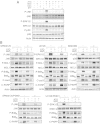BIMEL is a key effector molecule in oxidative stress-mediated apoptosis in acute myeloid leukemia cells when combined with arsenic trioxide and buthionine sulfoximine
- PMID: 24428916
- PMCID: PMC4029189
- DOI: 10.1186/1471-2407-14-27
BIMEL is a key effector molecule in oxidative stress-mediated apoptosis in acute myeloid leukemia cells when combined with arsenic trioxide and buthionine sulfoximine
Abstract
Background: Arsenic trioxide (ATO) is reported to be an effective therapeutic agent in acute promyelocytic leukemia (APL) through inducing apoptotic cell death. Buthionine sulfoximine (BSO), an oxidative stress pathway modulator, is suggested as a potential combination therapy for ATO-insensitive leukemia. However, the precise mechanism of BSO-mediated augmentation of ATO-induced apoptosis is not fully understood. In this study we compared the difference in cell death of HL60 leukemia cells treated with ATO/BSO and ATO alone, and investigated the detailed molecular mechanism of BSO-mediated augmentation of ATO-induced cell death.
Methods: HL60 APL cells were used for the study. The activation and expression of a series of signal molecules were analyzed with immunoprecipitation and immunoblotting. Apoptotic cell death was detected with caspases and poly (ADP-ribose) polymerase activation. Generation of intracellular reactive oxygen species (ROS) was determined using a redox-sensitive dye. Mitochondrial outer membrane permeabilization was observed with a confocal microscopy using NIR dye and cytochrome c release was determined with immunoblotting. Small interfering (si) RNA was used for inhibition of gene expression.
Results: HL60 cells became more susceptible to ATO in the presence of BSO. ATO/BSO-induced mitochondrial injury was accompanied by reduced mitochondrial outer membrane permeabilization, cytochrome c release and caspase activation. ATO/BSO-induced mitochondrial injury was inhibited by antioxidants. Addition of BSO induced phosphorylation of the pro-apoptotic BCL2 protein, BIMEL, and anti-apoptotic BCL2 protein, MCL1, in treated cells. Phosphorylated BIMEL was dissociated from MCL1 and interacted with BAX, followed by conformational change of BAX. Furthermore, the knockdown of BIMEL with small interfering RNA inhibited the augmentation of ATO-induced apoptosis by BSO.
Conclusions: The enhancing effect of BSO on ATO-induced cell death was characterized at the molecular level for clinical use. Addition of BSO induced mitochondrial injury-mediated apoptosis via the phosphorylation of BIMEL and MCL1, resulting in their dissociation and increased the interaction between BIMEL and BAX.
Figures









Similar articles
-
Arsenic trioxide induces oxidative stress, DNA damage, and mitochondrial pathway of apoptosis in human leukemia (HL-60) cells.J Exp Clin Cancer Res. 2014 May 16;33(1):42. doi: 10.1186/1756-9966-33-42. J Exp Clin Cancer Res. 2014. PMID: 24887205 Free PMC article.
-
BIM-mediated AKT phosphorylation is a key modulator of arsenic trioxide-induced apoptosis in cisplatin-sensitive and -resistant ovarian cancer cells.PLoS One. 2011;6(5):e20586. doi: 10.1371/journal.pone.0020586. Epub 2011 May 31. PLoS One. 2011. PMID: 21655183 Free PMC article.
-
Induction of apoptosis in arsenic trioxide-treated lung cancer A549 cells by buthionine sulfoximine.Mol Cells. 2008 Aug 31;26(2):158-64. Epub 2008 Jul 3. Mol Cells. 2008. PMID: 18596414
-
Arsenic trioxide: mechanisms of action.Semin Hematol. 2002 Apr;39(2 Suppl 1):3-7. doi: 10.1053/shem.2002.33610. Semin Hematol. 2002. PMID: 12012315 Review.
-
Combination therapy with arsenic trioxide for hematological malignancies.Anticancer Agents Med Chem. 2010 Jul;10(6):504-10. doi: 10.2174/1871520611009060504. Anticancer Agents Med Chem. 2010. PMID: 20812901 Review.
Cited by
-
Phosphatidylglucoside regulates apoptosis of human neutrophilic lineage cells.Front Immunol. 2025 May 27;16:1597423. doi: 10.3389/fimmu.2025.1597423. eCollection 2025. Front Immunol. 2025. PMID: 40496860 Free PMC article.
-
Evaluating the safety of intracameral bevacizumab application using oxidative stress and apoptotic parameters in corneal tissue.Int J Ophthalmol. 2015 Aug 18;8(4):697-702. doi: 10.3980/j.issn.2222-3959.2015.04.10. eCollection 2015. Int J Ophthalmol. 2015. PMID: 26309865 Free PMC article.
-
Hexokinase 3 enhances myeloid cell survival via non-glycolytic functions.Cell Death Dis. 2022 May 11;13(5):448. doi: 10.1038/s41419-022-04891-w. Cell Death Dis. 2022. PMID: 35538058 Free PMC article.
-
An overview of arsenic trioxide-involved combined treatment algorithms for leukemia: basic concepts and clinical implications.Cell Death Discov. 2023 Jul 27;9(1):266. doi: 10.1038/s41420-023-01558-z. Cell Death Discov. 2023. PMID: 37500645 Free PMC article. Review.
-
Reactive oxygen species in haematopoiesis: leukaemic cells take a walk on the wild side.J Exp Clin Cancer Res. 2018 Jun 26;37(1):125. doi: 10.1186/s13046-018-0797-0. J Exp Clin Cancer Res. 2018. PMID: 29940987 Free PMC article. Review.
References
-
- Niu C, Yan H, Yu T, Sun HP, Liu JX, Li XS, Wu W, Zhang FQ, Chen Y, Zhou L. et al.Studies on treatment of acute promyelocytic leukemia with arsenic trioxide: remission induction, follow-up, and molecular monitoring in 11 newly diagnosed and 47 relapsed acute promyelocytic leukemia patients. Blood. 1999;94(10):3315–3324. - PubMed
-
- Mathews V, George B, Lakshmi KM, Viswabandya A, Bajel A, Balasubramanian P, Shaji RV, Srivastava VM, Srivastava A, Chandy M. Single-agent arsenic trioxide in the treatment of newly diagnosed acute promyelocytic leukemia: durable remissions with minimal toxicity. Blood. 2006;107(7):2627–2632. doi: 10.1182/blood-2005-08-3532. - DOI - PubMed
-
- Zheng PZ, Wang KK, Zhang QY, Huang QH, Du YZ, Zhang QH, Xiao DK, Shen SH, Imbeaud S, Eveno E. et al.Systems analysis of transcriptome and proteome in retinoic acid/arsenic trioxide-induced cell differentiation/apoptosis of promyelocytic leukemia. Proc Natl Acad Sci U S A. 2005;102(21):7653–7658. doi: 10.1073/pnas.0502825102. - DOI - PMC - PubMed
-
- Jing Y, Dai J, Chalmers-Redman RM, Tatton WG, Waxman S. Arsenic trioxide selectively induces acute promyelocytic leukemia cell apoptosis via a hydrogen peroxide-dependent pathway. Blood. 1999;94(6):2102–2111. - PubMed
Publication types
MeSH terms
Substances
LinkOut - more resources
Full Text Sources
Other Literature Sources
Medical
Molecular Biology Databases
Research Materials
Miscellaneous

